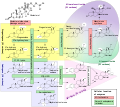Sex hormone
(Redirected from Sex steroids)
Sex hormones, also known as steroid hormones, are hormones that interact with vertebrate steroid hormone receptors. The sex hormones include the androgens, estrogens, and progesterones. They are responsible for the development of secondary sexual characteristics during puberty and for regulating the menstrual cycle and pregnancy.
Androgens
Androgens, such as testosterone, are the primary male sex hormones. They are produced primarily in the testes, but also in the adrenal glands. Androgens stimulate the development of male secondary sexual characteristics, such as increased muscle and bone mass, and the growth of body hair.
Estrogens
Estrogens are the primary female sex hormones. They are produced primarily in the ovaries, but also in the adrenal glands and fat cells. Estrogens stimulate the development of female secondary sexual characteristics, such as breast development and the growth of body hair. They also regulate the menstrual cycle and pregnancy.
Progesterones
Progesterone is a female sex hormone that plays a key role in the menstrual cycle and pregnancy. It is produced in the ovaries following ovulation, and prepares the lining of the uterus for implantation of a fertilized egg. If pregnancy does not occur, progesterone levels drop, triggering menstruation.
Role in Health and Disease
Sex hormones play a key role in health and disease. Imbalances in sex hormones can lead to a variety of health problems, including polycystic ovary syndrome, endometriosis, and certain types of cancer. Hormone replacement therapy, which involves taking synthetic sex hormones, is often used to treat these conditions.
See Also
Transform your life with W8MD's budget GLP-1 injections from $125.
W8MD offers a medical weight loss program to lose weight in Philadelphia. Our physician-supervised medical weight loss provides:
- Most insurances accepted or discounted self-pay rates. We will obtain insurance prior authorizations if needed.
- Generic GLP1 weight loss injections from $125 for the starting dose.
- Also offer prescription weight loss medications including Phentermine, Qsymia, Diethylpropion, Contrave etc.
NYC weight loss doctor appointments
Start your NYC weight loss journey today at our NYC medical weight loss and Philadelphia medical weight loss clinics.
- Call 718-946-5500 to lose weight in NYC or for medical weight loss in Philadelphia 215-676-2334.
- Tags:NYC medical weight loss, Philadelphia lose weight Zepbound NYC, Budget GLP1 weight loss injections, Wegovy Philadelphia, Wegovy NYC, Philadelphia medical weight loss, Brookly weight loss and Wegovy NYC
|
WikiMD's Wellness Encyclopedia |
| Let Food Be Thy Medicine Medicine Thy Food - Hippocrates |
Medical Disclaimer: WikiMD is not a substitute for professional medical advice. The information on WikiMD is provided as an information resource only, may be incorrect, outdated or misleading, and is not to be used or relied on for any diagnostic or treatment purposes. Please consult your health care provider before making any healthcare decisions or for guidance about a specific medical condition. WikiMD expressly disclaims responsibility, and shall have no liability, for any damages, loss, injury, or liability whatsoever suffered as a result of your reliance on the information contained in this site. By visiting this site you agree to the foregoing terms and conditions, which may from time to time be changed or supplemented by WikiMD. If you do not agree to the foregoing terms and conditions, you should not enter or use this site. See full disclaimer.
Credits:Most images are courtesy of Wikimedia commons, and templates, categories Wikipedia, licensed under CC BY SA or similar.
Translate this page: - East Asian
中文,
日本,
한국어,
South Asian
हिन्दी,
தமிழ்,
తెలుగు,
Urdu,
ಕನ್ನಡ,
Southeast Asian
Indonesian,
Vietnamese,
Thai,
မြန်မာဘာသာ,
বাংলা
European
español,
Deutsch,
français,
Greek,
português do Brasil,
polski,
română,
русский,
Nederlands,
norsk,
svenska,
suomi,
Italian
Middle Eastern & African
عربى,
Turkish,
Persian,
Hebrew,
Afrikaans,
isiZulu,
Kiswahili,
Other
Bulgarian,
Hungarian,
Czech,
Swedish,
മലയാളം,
मराठी,
ਪੰਜਾਬੀ,
ગુજરાતી,
Portuguese,
Ukrainian
Contributors: Prab R. Tumpati, MD







